by Todd Rutherford
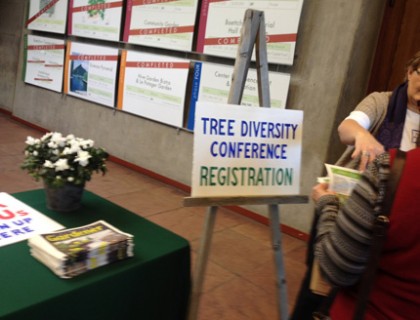
Attendees in the lobby of the Denver Botanic Gardens where the Tree Diversity Conference was held.
This past Spring, tree enthusiasts from around the region gathered at the Denver Botanic Gardens to listen and learn from various presenters on the theme of Tree Diversity for Colorado. It seems recent crises such as the discovery of Emerald Ash Borer infestation in Boulder has revealed the urgency for members of the Green Industry to seek out more hardy and appropriate tree species for our region. There are other reasons to seek out trees better adapted to our climate. As climate scientists continue to inform us, it is likely that Colorado’s climate will get warmer and drier, providing even more challenging growing conditions for trees. Also, biotic mixing will continue to increase as more people move goods and materials far and wide across the globe. That is the most probable scenario of how EAB was found in Boulder: it was brought there in a wooden crate shipped from Asia. What far-flung exotic pest will next appear in our area?
This year’s conference was the second occurrence of such a gathering in Denver. Several new tree species were presented to the audience, along with some old stand-bys, with a discussion of each tree’s merits.
Although there were several genera that are represented in the group of trees, the two genera with the most candidates are Maples and Oaks. The other genus with multiple species that should get wider consideration for planting in our area is Ulmus (elms). While most elms have been looked over because of Dutch Elm Disease and also the invasive nature of Siberian Elm (Ulmus pulmila), there are a few cultivars that we should consider planting in Denver.
Here are ten trees that were discussed at the conference (out of many others) that you might consider planting in Colorado and the surrounding region:
Acer grandidentatum ‘Manzano’ – Manzano Bigtooth Maple Ht: 20-30’ Wd: 20-30’
Large shrub or small tree with rounded form. The Manzano is a more tree like form of bigtooth maple. Once established, the bigtooth maples are drought tolerant.
Acer miyabei ‘Morton’ – State Street Maple Ht: 50’ Wd: 35’
Rough corky bark and leaf shape are similar to Hedge Maple, but its stronger growth rate and ascending branch habit result in a larger mature size. Excellent drought and cold tolerance. Very adaptable.
Acer saccharum ‘Collins Caddo’ – Collins Caddo Sugar Maple Ht: 45’ Wd: 40’
This maple provides red fall color, but unlike a red maple like Autumn Blaze (Acer x freemanii), the sugar maples are more adapted to the alkaline soils of Colorado’s Front Range urban corridor.
Acer tataricum ‘JFS-KW2’ – Rugged Charm Maple Ht: 28’ Wd: 15’
Compact oval form. More upright than the popular Hot Wings Tatarian maple.
Quercus macrocarpa ’Bullet Proof’ – Bullet Proof Bur Oak Ht: 50-80’ Wd: 50-80’
This large oak sports a massive trunk, deeply furrowed, that supports corky ridged twigs on spreading branches that makes for a broad and rounded canopy. This variety is more resistant to the galls that can affect other Bur Oaks.
Quercus muehlenbergii – Chinkapin Oak Ht: 40’ Wd: 40’
A durable and adaptable oak with narrow lustrous glossy dark green leaves and an open, irregular, rounded habit. Prefers well drained soil.
Quercus robur x alba ‘JFS-KW1QX’ – Streetspire Oak Ht: 45’ Wd: 14’
Dark green leaves of this narrowly columnar tree are mildew resistant. Turning red in autumn, they fall to reveal stiffly upright branches. Similar to Crimson Spire, but does not hold brown foliage through the winter
Ulmus davidiana – David Elm Ht: 40’ Wd: 30’
Medium sized tree, with vase shape. Resistant to Dutch elm disease.
Ulmus propinqua ‘JFS-Bieberich’ – Emerald Sunshine Elm Ht: 35’ Wd: 25’
Grown from seed collected in China, this sturdy, upright-growing elm was selected for superior performance on the hot, arid, windswept plains of western Oklahoma. Handsome, deeply corrugated leaves emerge coppery-bronze and mature to glossy green.
Ulmus japonica x wilsoniana ‘Morton’ – Accolade Elm Ht: 70’ Wd: 60’
Arching limbs and a graceful vase shape (similar to the American elm) characterize this hybrid elm selected and tested at Morton Arboretum. Glossy, dark green foliage changes to yellow in the fall and is resistant to elm leaf beetle feeding.
This is the official blog of Outdoor Design Group, Colorado Landscape Architects. For more information about our business and our services, click here.
Related Posts:
by Todd Rutherford
Who doesn’t love seeing the golden glow of aspen leaves (Populus tremuloides) dancing in the breeze on a mountain hillside? Many gardeners living at Colorado’s lower elevations have been smitten by the quaking leaves of aspen trees and tried to bring some of that mountain magic into their own yard. But doing so reveals lessons in plant ecology, and reminds us that not every plant we want to have in our home landscapes can easily grow there.
Aspens are a “succession” tree, moving into areas where other trees and shrubs were removed by logging, fire, erosion, insects or disease. As a succession species, they are not long lived. Their presence helps lead the way to other longer living trees.
In addition, aspens are highly susceptible to insect damages and diseases. Aspens that were collected in the wild are even more prone to damage and disease, as their root system is either injured or is incomplete during collection. Nursery grown aspens are generally healthier than collected ones, but still will likely succumb to problems and a shortened life.
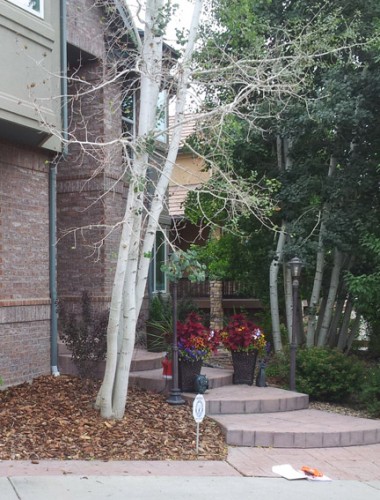
A diseased aspen tree.
Most arborists and horticulturists advise against planting Aspens along the Colorado’s Front Range. The growing conditions of the Front Range are different than those areas where Aspen thrive naturally. Aspens like to grow in gravelly, moist but well-drained soil with a lower pH (more acidic) that can typically be found at higher elevations. Along Colorado’s Front Range, our soils are typically heavy clay soils that don’t drain well and have a higher pH (more alkaline). Summer weather along the Front Range is hotter and drier than in the mountains, another factor going against the health of Aspens planted east of the high country.
If you really must have the quaking leaves of aspen in your yard, only plant them if you can place them in the north or east sides of your home (due to the afternoon heat of south and west exposures) and only if it is a nursery grown tree. Keep them away from objects that might radiate too much heat to the trees such as paving. Amend the soil with organic matter in an attempt to increase the acidity of the soil, and then mulch the newly planted tree well. You might also consider adding gravel or perlite to the soil before you plant to improve drainage, and reduce the problem of heavy clay soil.
Even if you can adhere to the aforementioned criteria while planting your aspen, it’s not likely your tree will achieve the brilliant gold of the aspens at higher elevations due to differences in soil chemistry, soil texture, soil moisture, day and night temperatures, and sunlight discrepancies at the different elevations. In addition you should be on the lookout for several different diseases and insects that more readily afflict aspens planted out of their native range.
Furthermore, if you want to remove aspen trees that are established in your yard, you may get many suckers (the stems that sprout up from aspen roots) coming up in your yard for many months after you removed the main trunk.
So in my opinion, no, aspen trees should not be planted in the Denver area, because it is not likely they will do well. But if you are aware of the many shortcomings of aspens planted outside of their native range, feel free to give them a try.
This is the official blog of Outdoor Design Group, Colorado Landscape Architects. For more information about our business and our services, click here.
Related Posts:
by Matt Corrion
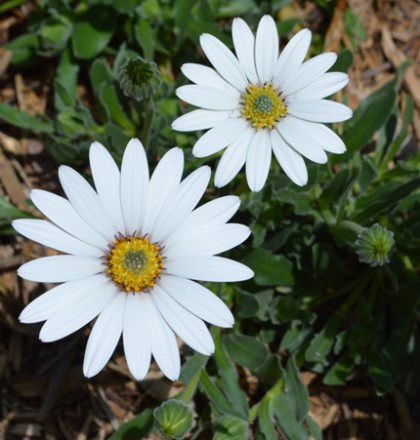
Osteospermum ‘Avalanche’ flowers
Looking for a low-growing, flowering perennial that will impress your friends and neighbors when they visit your garden? Look no further than the vigorous mat-forming daisy, ‘Avalanche’ White Sun Daisy. This cultivar, named to the Plant Select program in 2011, is related to other sun daisies, whose genus is originally native to South Africa. A shimmering riot of white, daisy-like composite flowers are produced above a mat of oblong, nearly succulent dark evergreen leaves. This variety of sun daisy is more disease resistant, blooms more heavily, and is more cold hardy than other Osteospermum cultivars. The numerous blooms close at night, showing off their metallic undersides of the petals.
Consider reserving a spot for this ‘Avalanche’ in your xeriscape or in the front of your sunny perennial planting beds.
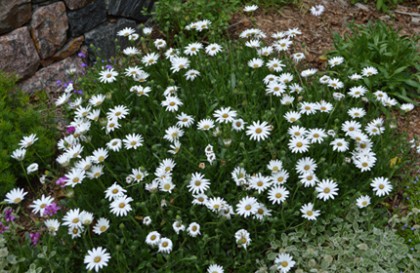
Osteospermum ‘Avalanche’
PLANT STATS
Scientific Name: Osteospermum ‘Avalanche’
Plant Type: Perennial Groundcover
Mature Height: 8″-12″
Mature Spread: 24″-42″
Cold Hardiness Zone: USDA zones 4 – 9 (up to 8,000 ft)
Water Requirement: Low to medium water needs. Seems to do equally well in dry conditions or with supplemental irrigation.
Exposure: Full Sun to light shade. I have experimented with it in my garden in afternoon shade, and it seems to do quite well.
Soil: Adaptable. I have planted it in some pretty heavy, poor clay soil and it seems to thrive there unlike many other Xeric perennials.
Flower Color & Bloom Time: Flowers are white with yellow-green centers, exhibiting a unique metallic tinge on the undersides of the petals. Blooms appear in early to mid-summer and continue in fall through the first frost. Sometimes flowering will slow down in late summer or in really hot, dry weather.
Winter Interest: Minimal.
Disadvantages: I have not found any to date. Some literature mentions that Osteospermum plants are susceptible to fungal pathogens.
Availability and Sizes: This plant seems to be regularly available at retail nurseries around the front range. It is typically sold in 1 gallon or 4″ pots.
Best Features: The flowers are beautiful, but to me what really sets this plant apart is the mass of dark green foliage. In the right conditions it develops a wide mat of dark green foliage that acts a groundcover, spreading up to 42″ wide.
Maintenance Tip: While drought tolerant, Avalanche White Sun Daisy will produce the best flowers and mat of foliage if it is watered once or twice per week during dry periods.
This is the official blog of Outdoor Design Group, Colorado Landscape Architects. For more information about our business and our services, click here.
Related Posts:
by Todd Rutherford
I wanted to revisit Matt’s post on the 20 Best Xeriscape Plants for Colorado, and add to his list of great low-water plants for Colorado landscapes. As with Matt’s initial posting, this list of plants also offers a great variety of color, texture and form for your water-wise garden. Consider adopting some of these amazing plants into your landscape, and tell all your friends about the benefits and beauty of drought tolerant plants.
Perennials:
- Chocolate Flower – Berlandiera lyrata An intoxicating chocolate scent emanates from the yellow blooms of this low water southwestern wildflower from summer into fall.
- Whirling butterflies – Gaura lindheimeri Whirling Butterflies truly lives up to its name. Growing 2-3’ tall by 18-24” wide, this perennial has a significant bloom time, sporting multiple flower stalks that whirl numerous small white flowers in the late summer breezes.
- Creeping Veronica – Veronica spp. A spring blooming favorite, creeping veronicas are somewhat adaptable to light and moisture conditions. The deep green foliage is often evergreen in winter and makes a nice backdrop to the abundant light blue to purple flowers that arrive in April.
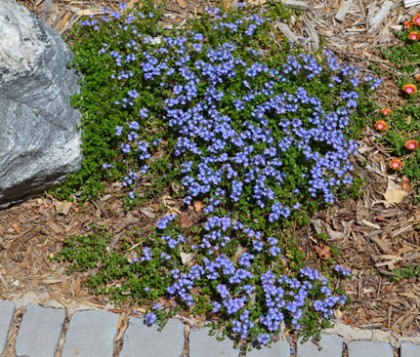
Creeping Veronica
- Sweet Woodruff – Gallium odoratum No dry shade garden should be without this fabulous groundcover. If you have a dry shady spot under a tree, this is the plant for you. It is said that sweet woodruff is one of the few plants that will flourish under the shady canopy of evergreen trees. Small bright green leaves become decorated with tiny white flowers in late spring.
- Orange Carpet Hummingbird Flower – Epilobium canum garrettii If hummingbirds pass through your area consider this California native. It provides a stunning orange floral display in late summer that hummingbirds love, and is ideal to let cascade down a rock wall.
- Blanketflower – Gaillardia aristata Related to sunflowers, this is another North American native that is a great addition to the low-water garden. It blooms from June to September with flower petals that transition from yellow to orange to red. Many cultivars available. Easy to start from seed.
- Silvery Horehound – Marrubium rotundifolium This native of Turkey is a great xeriscape ground cover. It grows 2-4” high and 2-3’ wide. Soft white hairs on the round leaf margins add an effulgent look to the plant.
- Hens and Chicks – Sempervivum spp. This familiar garden succulent from Europe is a hardy performer that will grow just about anywhere. Great for the small spots between other low perennials or rock gardens in full sun. Another nice benefit is how easy it is to transplant the offshoots they provide. Several types are available, with some covered in charming white hairs.
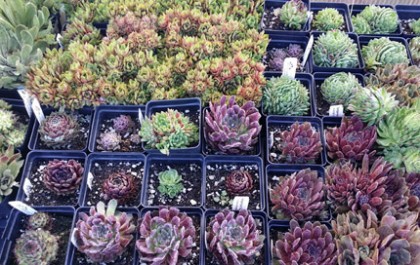
Variety of Sempervivum, a.k.a. Hens and Chicks
- Sunrose – Helianthemum This hardy low-growing perennial provides a delightful floral display starting in June. The profuse blooms hover over a thick mass of low branches that carry small, oval shaped leaves. The flower color is available in shades of red, orange, yellow, pink and white. Perfect for a rock garden or a hot and sunny border area.
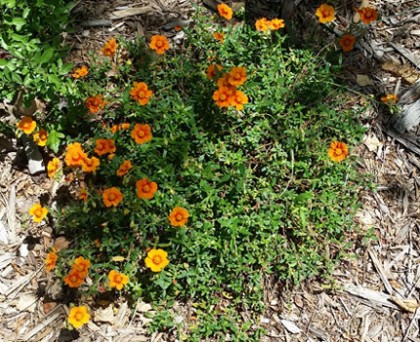
Orange Sunrose
Grasses:
- Blonde Ambition – Bouteloua gracilis ‘Blonde Ambition’ This is a wonderful medium sized grass, 30-36” high and 30-36” wide. It provides multiple seasons of interest, showcasing the classic blue grama grass curled seed heads well into winter.
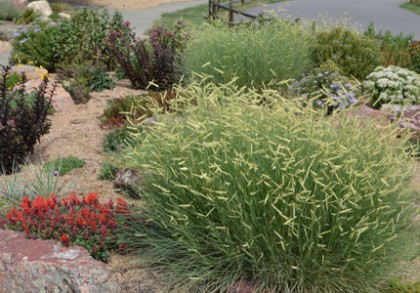
‘Blonde Ambition’ Blue Grama Grass
- ‘Undaunted’ Ruby Muhly – Muhlenbergia reverchonii A 2014 Plant Select introduction. Discovered by Lauren and Scott Ogden, it hails from Oklahoma and Texas. The inflorescence (aka flower cluster) is composed of clouds of tiny pinkish flowers, creating a pink glow with back lighting.
Shrubs:
- Currant – Ribes spp. Currants are medium sized shrubs that grow well in sun, and some species also grow well in filtered shade. This is a notable fact, as many shrubs that do well in part shade require more water than the currants do. Some species provide edible fruit, and some have fragrant flowers. The most notable fragrant currant is Crandall Clove Currant, whose flowers do indeed smell like cloves.
- Dwarf Russian Almond – Prunus tenella Native to Eurasia, this flowering shrub is said to be hardy to zone 2!!! Abundant with pink flowers in the spring, one disadvantage of this shrub is the aggressive suckering habit which may make it hard to control, but this also makes it an attractive cover for wildlife. Size is 3-5’ x 3-5’.
- Dwarf Pinyon Pine – Pinus edulis This slow growing selection of pinyon pine was introduced by Plant Select in 2014. Grows 20-30” height by 20-30” width in 10 years.
- Mohican Viburnum – Viburnum lantana ‘Mohican’ Another great low water shrub that does well in either full or part sun, this viburnum grows 6’ by 6’. White flowers in spring precede orange to red fruits that darken to black in fall.
- Mountain Mahogany – Cercocarpus spp. This western native is indispensable if you’re planning on creating a large native style landscape. Some species are semi-evergreen and one species Cercocarpus montanus the leaves turn a nice russet color in fall. Seeds provide a charming fuzzy appearance that looks great when backlit.
- Peashrub – Caragana spp. A tough shrub from Siberia and China, the peas shrub is, just as the name indicates, related to peas. It produces edible (but not palatable) pods and edible yellow flowers that interest to salads. There are several different species and cultivars to choose from, which range in size from medium to large.
Trees
- Bigtooth Maple – Acer grandidentatum Native to the inter-mountain West, and closely related to the sugar maple. Often growing as multi-stem, it likes full sun to partial shade and low to medium water. The samaras, or winged seeds turn rose color in late summer, and the fall foliage ranges from yellow to red. Grows 20-30’ high by 20-30’ wide.
- Desert Willow – Chilopsis linearis Another typically multi-stem small tree, it is hardy to zone 7 (0 to 5 deg F), but usually survives Denver winters, dying back to the ground each winter, and quickly sprouting new growth each summer. If given a sheltered spot, it may not die back to the ground. Distinctive pink to burgundy flowers with yellow throats. Drought tolerant, with watering being deep and infrequent. Grows 6-30’ high by 6-30’.
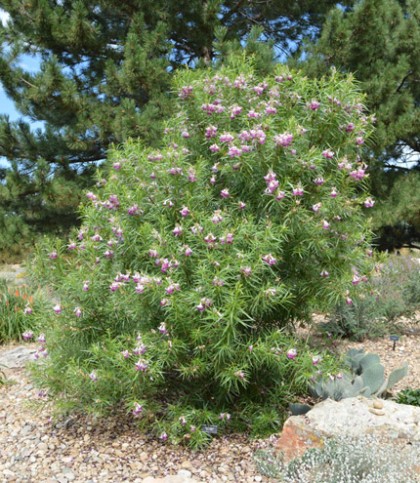
Desert Willow
- Hawthorn – Crataegus spp. These flowering trees are cousins of roses, and bloom in spring with clusters of white flowers that produce long lasting red fruits that offer winter interest. Several species and cultivars have thorns on the branches. Grows 15-25’ high by 15-25’ wide, depending on species and cultivar.
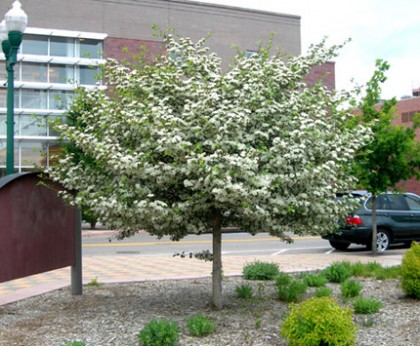
Hawthorn
The Criteria for this List:
– This list is for the Front Range of Colorado. We are somewhere in the middle of zone 4 to 5 on the USDA Plant Hardiness Zone Map.
– I have only included plants that are very easy to care for, and have excluded plants that require a lot of water since that is a key component of Xeriscape. The “best” plants, in my opinion, are those that are well adapted to the local climate and do not require much additional water and maintenance. Of course there are occasions where the use of higher water-use plants is desirable, such as in drainage areas, however I have left them off of this particular list.
This is the official blog of Outdoor Design Group, Colorado Landscape Architects. For more information about our business and our services, click here.
Related Posts:
by Todd Rutherford
You may have heard recent dire reports about the health of bees and butterflies. Whether it’s the declining number of the amazing Monarch Butterfly or the constant reports of “colony collapse disorder” in beehives, these reports are alarming. One of the best and easiest things you can do to help these crucial creatures survive and thrive is to plant the perennials, shrubs and trees in your landscape that will give bees and butterflies the food they depend on. Help these pollinators while creating an inviting outdoor space for yourself. Or, if you are pondering the possibility of updating your landscaping in the near future, let Outdoor Design Group design a bee and butterfly friendly garden for you.
Below are listed several different perennials, shrubs and trees that provide food for bees, butterflies and other pollinators. While I’ve listed several pollinator friendly plants here, there are still many more to choose from. Consult the Xerces Society, a nonprofit organization that protects wildlife through the conservation of invertebrates and their habitat, or your local university extension agent for more suggestions of pollinator friendly plants that will grow well in your area.
Perennials for Butterflies and Bees
Asclepias species. Commonly referred to as the Milkweeds due to their milky sap, there are many species in the Asclepias genus that are utilized by butterflies and bees. Many biologists believe that the decline in the Monarch butterfly population is directly correlated to the increasing use of herbicides used to kill Milkweeds in North America, because Monarch butterflies depend on Milkweeds as food for their larvae. There are many Asclepias species that grow in North America, but two that do well in Colorado are Asclepias tuberosa (showy milkweed) and Asclepias speciosa (butterfly weed). Ht. and Wd. varies depending on species and cultivar, generally 15-60” Ht. x 12-18” Wd.
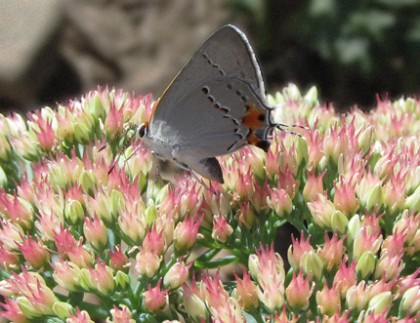
The Mint Family (Lamiaceae). Many familiar and popular garden plants from the so-called Mint Family are favored by bees. Some of these are culinary sage, Russian sage, mint, basil, rosemary, oregano, thyme, lavender, lamb’s ear, hyssop, lemon balm, and bee balm. Ht. and Wd. varies depending on species and cultivar.
Sedum ‘Autumn Joy’. This tall stone crop flowers in mid to late summer (see photo above), making it a good late-season nectar source for pollinators when many other plants have stopped flowering. 18-24” Ht. x 12-18” Wd.
Datura wrightii Although Sacred Datura may not always be a perennial in all parts of Colorado, depending on the severity of the winter, bees love it’s flowers which emit an amazing scent, so even if it is frost tender and may need to be regrown from seed in colder areas, it is worth it. The bees will thank you. 18-24” Ht. x 6-8’ Wd.
Shrubs for Butterflies and Bees
Buddleia alternifolia ‘Argentea’, Silver Fountain Butterfly Bush. This butterfly bush blooms earlier than the other species and cultivars of Buddleia. This large shrub does well in most soils and sites but doesn’t like its roots to stay wet. 12-15’ Ht. x 10-12’ Wd.
Caryopteris x clandonensis ‘Blue Mist’. Blue Mist Spirea is also in the Mint Family, and is not a true spirea, but has flowers that resemble those of the spirea. It is a hybrid of C. incana x C. mongolica that was created in the 1930’s in England by Arthur Simmonds. There are several cultivars of Caryopteris x clandonensis that are good choices for Colorado and which bees and butterflies (see photo below) love. 3-4’ Ht. x 2-3’ Wd.
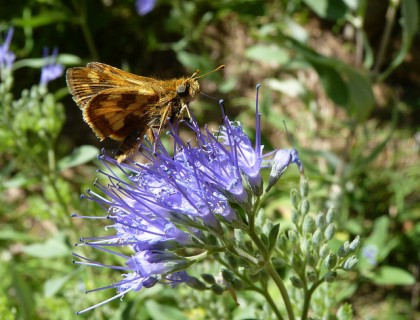
Mahonia. This genus has several members whose flowers will delight your winged friends. Mahonia aquifolium is a familiar shrub known as Oregon Grape Holly. It is evergreen, easy to grow and produces edible (but not tasty) berries from the yellow flowers that bees appreciate. 4-6’ Ht. x 4-6’ Wd.
Prunus bessyi, Sand Cherry 4-6’ Ht. x 4-6’ Wd.
Philadelphus lewisii, Cheyenne Mock Orange 5-7’ Ht. x 4-6’ Wd.
Rhus aromatica ssp. Trilobata, Three leaf sumac 3-6’ Ht. x 3-6’ Wd.
Rosa woodsii, Wood’s Rose 3-6’ Ht. x 3-6’ Wd.
Trees for Butterflies and Bees
Tilia cordata, Little Leaf Linden. Linden trees perfume the air in springtime and offer up small yellow flowers (see photo below) for pollinators. I’ve heard that in Eastern Europe, a type of beer is flavored with the linden flowers. 30-50’ Ht. x 25-35’ Wd. (depends on cultivar).
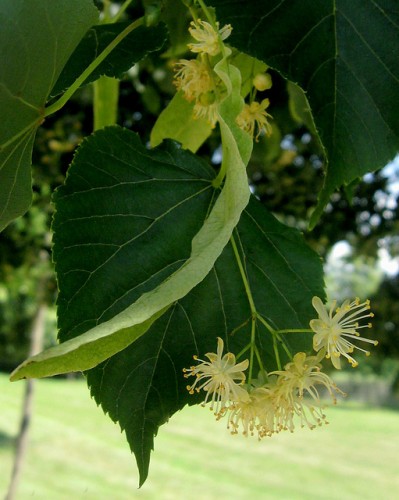
Apple / Crabapples. The Malus genus offers many species and cultivars that are attractive to bees. In fact, if there were no bees, you probably would not get any fruit from your apple trees. Ht. and Wd. varies depending on cultivar.
Prunus armeniaca ‘Moongold’, Moongold Apricot. 15-25’ Ht. x 15-25’ Wd.
Prunus nigra ‘Princess Kay’, Princess Kay Plum 15-20’ Ht. x 10-15’ Wd.
Catalpa speciosa, Western Catalpa 40-60’ Ht. x 30-50’ Wd.
Cercis Canadensis, Eastern Redbud 20-30’ Ht. x 20-30’ Wd.
Crataegus ambigua, Russian Hawthorne 15-25’ Ht. x 20’ Wd.
This is the official blog of Outdoor Design Group, Colorado Landscape Architects. For more information about our business and our services, click here.
Related Posts:












